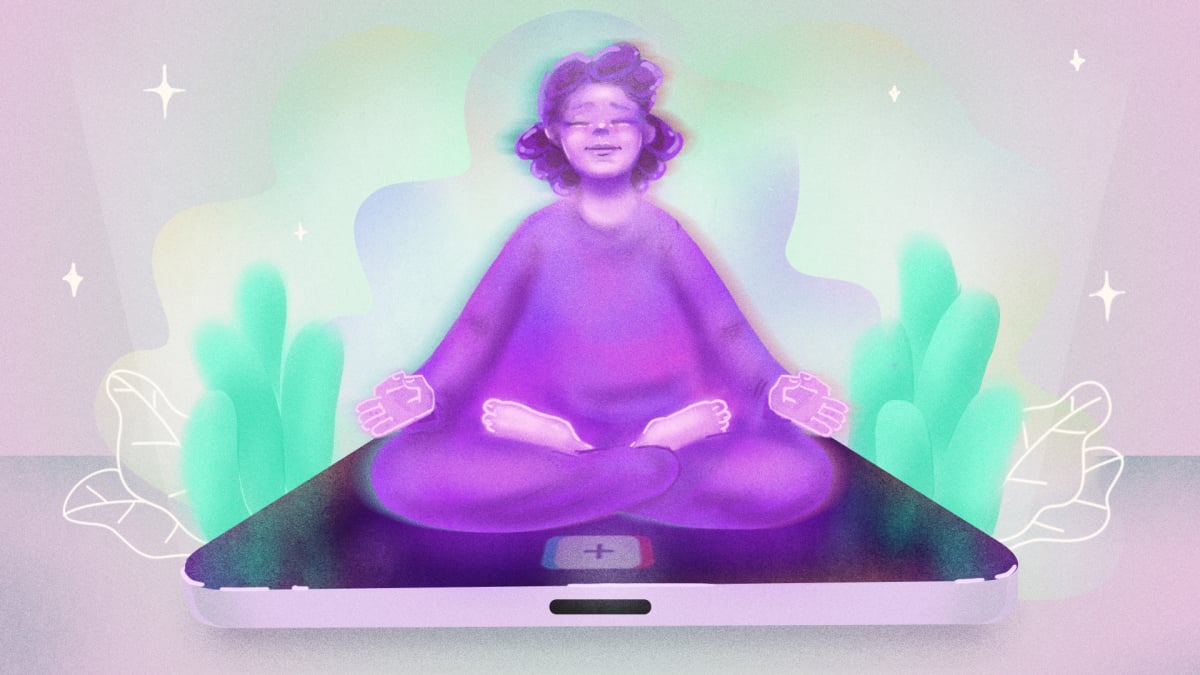Entertainment
TikTok is more mindfulness-coded than you may think

TikTok users are in the mood to manifest. But do they know what they’re manifesting?
The concept of willing the universe to grant everything you want, sometimes referred to as “Lucky Girl Syndrome,” came alongside a surge in popularity of platform-wide mantras and affirmations in 2023.
Manifestation mania followed another very 2020s TikTok trend: “shifting,” or basically lucid dreaming for views. A community of “shifters” alleged they spent hours in “alternate universes” living out completely different lives, often with fictional characters. Some made guided meditations, or used others’, to help shift into their dream selves.
Throw in the increasing popularity of yoga influencers, mental health and wellbeing professionals, and gentle parenting accounts on the rise in the wake of a traumatic pandemic. All these coping tools boil down to one simple, ongoing TikTok trend: mindfulness.
Definitions of mindfulness are often as varied as TikTok’s interpretations of the practice. We’ve previously described it as “awareness gained by pausing to register one’s emotions,” or “the ability to observe thoughts and feelings non-judgmentally, and with compassion and curiosity.”
Academics such as Jon Kabat-Zinn define mindfulness as “paying attention in a particular way: on purpose, in the present moment, and non-judgmentally.” According to professor of psychology J. David Creswell, it’s “present attention to your present situation.” Meditation teacher Jeff Warren, a proponent of accessible meditation practices, points to the concept of equanimity, or “allowing self and world to be exactly what they are in a given moment.”
All of that may seem like the opposite of an instant-gratification platform like TikTok. But increasingly, the platform is a tool for popularizing mindfulness in one form or another.
TikTok hits the Reset button
Nestled next to “Get Ready With Me” makeup and fashion TikToks, there’s a growing trend of “Daily Reset” videos, also known as “quiet life vlogs.”
These TikToks are a kind of routine video that documents a user’s mundane daily tasks. Essentially a form of present attention, these videos invite viewers into a creator’s moments of stillness and ritual.
Many of the videos are tagged #QuietLife, alluding to a lifestyle that embraces calmness and simplicity. Related: the “Silent Walk” trend, a version of TikTok’s “Hot Girl Walk” — one that asks participants to walk without any kind of agenda, in complete silence.
True, some TikToks present unrealistic forms of self-optimization, or promote overconsumption. Parenting videos offer unapproachable standards. You could see the #QuietLife videos as a humblebrag — or they may help you feel gratitude for your life.
‘Stop scrolling’ videos encourage pauses
It isn’t just TikTok itself trying to curb mindless scrolling on its app, via pop-up videos warning users to take a screen break. Creators in the health and wellness sphere are choosing to combat the infinite scroll with their own content.
Your endless FYP perusal might be interrupted by a pilates instructor asking you to stop and do some simple stretches, nudging you away from the phone. Other creators may ask you to simply pause and look up. You may come across breathwork teachers (or businesses) teaching you how to do simple breathing exercises, or disability advocates teaching neurodivergent communities how to attune their environments to their mental needs.
In short, users are trying to shift TikTok’s isolating experience into a communal acknowledgement that we all need to take a moment. You can acknowledge the entirety of your awareness, not just the bit that’s focused on your phone.
TikTok embraces its inner child
In the wake of Greta Gerwig’s 2023 mega-hit Barbie and its message of finding yourself and honoring your past, TikTok users are obsessed with speaking directly to their inner child. To the soundtrack of Billie Eilish’s “What Was I Made For”, users are exploring the emotions of aging, mourning the experiences and lives they could have had, and channeling their childhood imaginations to see the world afresh.
Other nostalgic trends involve returning to favorite childhood pastimes or niche obsessions. Parenting circles are exploring what it really means to “gentle parent.” Followers are encouraged to become more attuned to their own past in order to break the cycles of trauma with their own children.
These trends embrace the mindfulness principle of “beginner’s mind,” or the practice of seeing the world with fresh eyes. While not quite up to the level of a guided inner child healing meditation or other research-based practices, TikTok’s inner child trend centers the feeling of wonder and innocence, as both a comfort and a place of learning.
Journaling goes viral
Even before the rise of TikTok shop, the platform was awash in products such as the viral Shadow Work Journal, based on the concept of hidden trauma proposed by psychoanalyst Carl Jung. The journal blew up via sponsored posts and product-oriented wellness spaces, despite some mental health professionals seeing it as a dubious product. Still, users embraced the notion of at-home journaling as a way to process emotions.
Last year, The Sadness Book: A Journal to Let Go from Modern Frame of Mind rose to popularity. There are several similar guided journaling books, offering prompts and affirmations.
Journaling content, broadly, is popular across the app, from aesthetic-driven journaling accounts to users who share readings from their journals. Many of these are effectively practicing mindfulness journaling, or the act of writing down your thoughts, emotions, and experiences in a non-judgmental way.
Livestream the silence
ASMR, the whisper-based content intended to create comforting tingles in the minds of viewers, has also found a home on TikTok. Some ASMR videos include “trigger tests”: Different types of sounds and visuals designed to stimulate different types of ASMR responses.
But there’s also a trend of deliberately non-stimulating live streams, in which creators make very subtle sounds, or do simple activities, while thousands of people watch. Some live streamers literally sit in silence, usually with a sign posted in frame or a caption that ask those who join to sit with them… and sometimes tip them.
One mindfulness trend is “Wood Soup,” or a bowl of water filled to the brim with wooden beads and trinkets. The “soup” is then softly stirred by a faceless hand. Livestreams of wood soup are sometimes paired with meditative chants, rain noises, or gentle music.
Better sleep through meditation
Whether it’s Calm app collaborations with influencers reciting meditations, or its abundance of life hacks and How-Tos, TikTok users often seem obsessed with calming themselves down and getting to sleep.
Viral trends include sounds designed to stimulate different parts of your brain, also called bilateral music stimulation, which is used in various therapies like EDMR and a practice known as “brainspotting.”
Breathing exercises packaged as sleep or relaxation hacks are also popular, alongside sensory and grounding techniques that those who already meditate may recognize. Meanwhile, guided sleep meditations are a large subset of the ASMR videos mentioned above.
Of course, we shouldn’t ignore TikTok’s long standing reluctance to admit the platform is missing the mark in the mental wellness space. The parent company can do more to protect users and prevent misinformation and disinformation, including when it comes from mental health “practitioners.” The infinite scroll, the lack of moderation, the accusations of child endangerment: Suspicion over TikTok’s ability to aid users’ wellness journeys is warranted.
Nevertheless, users are taking their mental wellbeing into their own hands. They’re making genuine attempts at building human connection, and helping us find coping mechanisms in such a digital space.
Silly memes and absurdist audio may dominate, but if you look in the more earnest corners of TikTok, you’ll find creators dipping their toes into mindfulness techniques that may actually help.
Topics
Mental Health
TikTok
-

 Business6 days ago
Business6 days agoTesla’s new growth plan is centered around mysterious cheaper models
-

 Business7 days ago
Business7 days agoUnitedHealth says Change hackers stole health data on ‘substantial proportion of people in America’
-

 Business5 days ago
Business5 days agoXaira, an AI drug discovery startup, launches with a massive $1B, says it’s ‘ready’ to start developing drugs
-

 Business5 days ago
Business5 days agoUK probes Amazon and Microsoft over AI partnerships with Mistral, Anthropic, and Inflection
-

 Entertainment4 days ago
Entertainment4 days agoSummer Movie Preview: From ‘Alien’ and ‘Furiosa’ to ‘Deadpool and Wolverine’
-

 Business4 days ago
Business4 days agoPetlibro’s new smart refrigerated wet food feeder is what your cat deserves
-

 Business6 days ago
Business6 days agoTwo widow founders launch DayNew, a social platform for people dealing with grief and trauma
-

 Entertainment6 days ago
Entertainment6 days agoTesla’s in trouble. Is Elon Musk the problem?




























